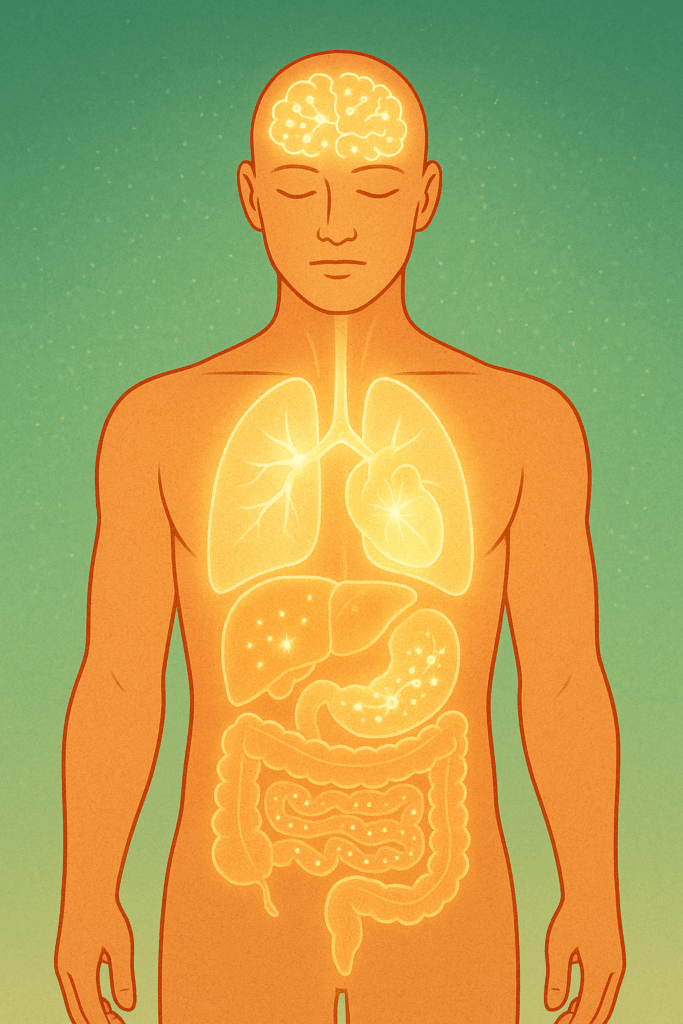What Happens During a Fast
When food intake stops, digestion pauses and the body turns inward. Instead of channelling energy toward processing food, it begins to cleanse, repair, and regenerate. This shift allows the cells to focus on maintenance and restoration. The process known as autophagy, recognised by the 2016 Nobel Prize in Physiology or Medicine, describes how the body disassembles damaged cells and recycles their components for new growth.
Scientific studies confirm that fasting activates autophagy, lowers inflammation, and enhances cell survival (Mizushima & Levine, Nature Medicine, 2020). As the digestive system rests, circulation improves and stored waste begins to move. The liver, kidneys, and lymphatic system become highly active, releasing residues that have accumulated from processed foods, medication, and environmental toxins. This increased cleansing capacity is what often brings about the healing crisis that Natural Hygiene recognises as a sign of progress.
Understanding the Healing Crisis
A healing crisis is the body’s response to the sudden freedom it gains when interference ceases. The system begins to cleanse more deeply, unburdened by constant intake. This can result in temporary symptoms such as headaches, coated tongue, nausea, fatigue, skin eruptions, or heightened emotions. These reactions are not illness returning, but old material being expelled.
From a biological view, fasting induces a metabolic shift called ketosis, where the body transitions from using glucose to burning stored fat for energy. Research by Longo & Panda (Cell Metabolism, 2016) shows that during this phase, toxins stored in fat cells are released into the bloodstream to be processed and excreted. This can temporarily overload elimination channels, producing symptoms that mirror disease. However, once this phase passes, most people report increased vitality, clearer skin, better sleep, and a sharper mind.
Why the Crisis Is a Sign of Healing
Natural Hygiene teaches that the body is self-regulating, intelligent, and always working toward balance. A healing crisis is simply a period of accelerated house-cleaning. The blood becomes cleaner, the lymphatic system more active, and the organs begin functioning at higher efficiency.
When toxic matter is stirred up, discomfort is a sign of movement, not of malfunction. This principle echoes scientific observations showing that controlled fasting enhances mitochondrial health, lowers oxidative stress, and promotes tissue repair (de Cabo & Mattson, New England Journal of Medicine, 2019). What appears to be illness is often the very process through which health is restored.
Emotionally, fasting can also bring long-buried feelings to the surface. As the physical body detoxifies, the nervous system releases tension patterns, allowing unresolved emotions to clear. This alignment between body and mind contributes to the profound sense of peace that many people experience after a complete fast.
Navigating the Process Safely
The body’s pace must be respected. Rest is the most important medicine during a healing crisis. When the body demands stillness, it is directing its energy toward internal repair. Clean water, sunlight, and fresh air are the best supports during this time.
Avoid stimulating the body with caffeine, herbs, supplements, or unnecessary treatments. Let nature take its course. If symptoms become intense, easing the fast with diluted fruit juices or watery fruits like melon can help moderate the process. Always reintroduce food slowly. Begin with fresh fruits, tender greens, or a mono-meal to allow the digestive enzymes to awaken gently.
Those with chronic conditions or extensive toxicity should prepare with shorter fasts first—one day, then three, then five. Gradual progression allows the organs to strengthen and the lymphatic system to adapt. Under the Natural Hygiene approach, fasting is never a battle against disease but a cooperative return to balance.
A Return to Simplicity
Modern science and Natural Hygiene now converge on the same truth: the body has immense power to restore itself when given rest. Fasting is not deprivation but renewal. By removing the constant load of food, the body reclaims its clarity, vitality, and natural rhythm.
Healing crises remind us that discomfort is sometimes the gateway to restoration. Through patience, rest, and trust in the body’s intelligence, we allow regeneration to unfold.
References
- Mizushima, N., & Levine, B. (2020). Autophagy in human diseases. Nature Medicine, 26(4), 677–688.
- Longo, V. D., & Panda, S. (2016). Fasting, circadian rhythms, and time-restricted feeding in healthy lifespan. Cell Metabolism, 23(6), 1048–1059.
- de Cabo, R., & Mattson, M. P. (2019). Effects of intermittent fasting on health, aging, and disease. New England Journal of Medicine, 381(26), 2541–2551.
Checkout Diseases we treat


